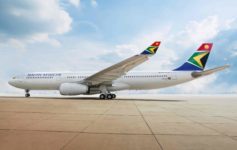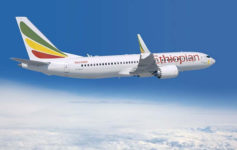Ethiopian Airlines has released a preliminary report on the deadly crash of ET 302, placing the blame squarely on Boeing.
At a news conference in Addis Ababa, Ethiopia’s Minister of Transportation Dagmawit Moges leveled this damning assertion:
The crew performed all the procedures repeatedly provided by the manufacturer but was not able to control the aircraft.
In a statement on Twitter, Ethiopian elaborated:
The preliminary report clearly showed that the Ethiopian Airlines pilots who were commanding flight ET 302 followed the Boeing recommended and FAA approved emergency procedures to handle the most difficult emergency situation created on the airplane. Despite all their hard work and full compliance with emergency procedures, it was very unfortunate that they could not recover the airplane from the persistence of nose-diving,
Moges’s recommendations include Boeing reviewing the aircraft control system and strict regulatory oversight before allowing any 737 MAX into the air again.
Since repetitive uncommanded aircraft nose down conditions are noticed … it is recommend that the aircraft control system shall be reviewed by the manufacturer.
We are still waiting for the full release of the preliminary report.
CONCLUSION
The question remains…and continues to remain…whether the plane crashed due to a faulty Maneuvering Characteristics Augmentation System (MCAS) or because the pilots did not know how to handle the MCAS system. That question may never be unequivocally answered. But Ethiopian’s preliminary report strikes a blow against Boeing.




To me that is not the question at all. If that MCAS is soo bloody complicated to handle then it seems that Boeing has done a very poor job in designing it in the first place.
I am not a DT fan but on this one he is right: I do not want to be on a plane thats designed to be flown by Einsteins only.
Boeing took shortcuts in design, testing, certification for reasons that AA otherwise would have placed a substantial order with Airbus. And that makes them responsible.
These things will not fly anytime soon again. Boeing may be able to lean on some US companies, other countries regulators will not easily re-certify these things.
It makes me laugh at all the talking heads and bloggers who were defending Boeing and the FAA decision not to ground the plane after this accident. Americans are SO capitalistic. Clearly safety is not OUR priority, $ is.
The chicken have come home to roost for Boeing. Boeing should be taking out their cheque book and stocking up on their signing pens.
The more that comes out about this the more Boeing seems to be in the wrong here. Instead of designing a new plane took a plane based on a design originally made over 50 years ago and stretched it beyond its limits. The fact that the MCAS system needed to exist at all suggests that the engineers had to work around a physically impossible design goal to make the MAX. I understand why Boeing didn’t want to build a new 737 replacement from scratch as that would cost way more in time and money and they would lose a ton of orders to the A320 NEO series, but people have now payed for Boeing’s greedy shortsightedness with their lives.
I’m really curious about this statement here, “…or because the pilots did not know how to handle the MCAS system.”
Matthew, why are you trying so hard repeatedly to blame the pilot?
Some reading into perspective: https://qz.com/1584233/boeing-737-max-what-happened-when-one-us-pilot-asked-for-more-training/amp/
Had either one of these accidents happened in the USA Boeing would be a penny stock and would be well on their way to becoming the next ValueJet. While both of these accidents happened overseas, lawsuits will still make their way to the USA and this will hurt Boeing for a long long time. BOEING should have grounded the planes on their own after Indonesia and waited until they had a software fix. The CEO of Boeing should resign tomorrow and the engineers in charge of designing and approving the MCAS should all be fired or forced to resign.
A lemon marketed and sold as an orange, with tragic consequences.That’s what happens when bean counters and marketing sleazebags win out over engineers ( the internal disputes within Boeing have been widely reported).
If it hadn’t been for the NYT and others, it’s quite likely that this would have been buried in the context of “ unfortunate third world crashes caused by incompetent pilots”, until the next one.
And yet, even after 2 crashes in short order, many of the Boeing lapdogs/lickspittles continued to say that grounding was premature. Utterly disgraceful/ scandalously unprofessional.
I’m not forming a queue to be an early passenger on the 779.
I’ve predicted from the start that Ethiopian authorities would lay the blame squarely on Boeing, despite there being overwhelming evidence that the pilots were insufficiently trained to operate this aircraft (and where that blame lies is more complicated).
Ethiopia, as a nation, has too much invested in the reputation of Ethiopian Airlines for their air safety bureaucrats to be allowed to issue an independent report that placed blame anywhere but on Boeing.
This is literally “fake news” in that the report from the Ethiopians is based on politics, not facts.
Anything but the USA is wrong! Fake news!
Wow…. No wonder you people still uses body parts to measure things.
MCAS was definitely the initiating factor here but the pilots kept engine thrust at 100% during the entire accident sequence (except for the final few seconds). Airspeed was increasing the whole time and the overspeed warning came on as they were climbing. As others have noted on other websites, it’s very difficult to manually move the trim wheel when pulling back on the controls because of increasing aerodynamic forces, and thus they (likely) turned the trim motors back on to try to regain control.
Most likely, a more experienced set of pilots would have pulled back the throttle rather than turn the trim motors back on.
Boeing’s fault here is that they didn’t say anything about how hard it would be to undo the trim inputs from MCAS without the trim motors active (because of the stab trim cutout selection).
There still shouldn’t be a plane that requires a system like MCAS if it’s being marketed as a plane that requires minimal training for current 737NG pilots. If Boeing was unwilling to make a new plane and needed MCAS to make the MAX possible, all pilots should have been made aware of the situation and have been required to be trained to get up to speed with the new system. I get why Boeing didn’t want to start from scratch, but if their solution to the problem of making a 50 year old airframe handle much bigger engines was something like MCAS, it should have at least required retraining.
I just read that EU pilots have now come forward with sincere doubts on both design as well as lack of training. In other words, unlikely they will fly the bugs again unless they are fully convinced it is safe.
As I understand, both LionAir and Ethiopian elected to not purchase an optional safety mechanism.
I can see where they are coming from. I am not an aircraft purchaser, but I do think to my experience buying a car; the dealers love to promote all sort of safety mechanisms as options, but they may not have data to demonstrate their effectiveness, making me reluctant to buy one of these options. I would hope that, in buying a plane, purchasers do even more research than me and can accurately determine which safety mechanisms are fluff and which ones are worth buying.
However, Boeing has a defense that they recommended this safety option and therefore shouldn’t be liable for Ethiopian’s decision to not purchase it,
“optional safety mechanism” the word “optional” comes first prior to safety.
I cannot fathom the consequences of putting those 2 words in a sentence, moreover a phrase.
Is FAA/Boeing deemed safety is optional? Or simply without such mechanism safety already achieved, thus it is optional.
Then again, someone’s mishap is an opportunity for others. For example, take media outlet who defended Boeing &/ FAA or at least tried to shift blame and responsibilities by arguments such as “the pilot didn’t have enough flying hours” or “i’m a pilot (claimed-anon), but i won’t make mistakes like those who perished”.
Let’s get back to trip reviews, shall we?
Frankly I think your conclusion is flawed. The question does not remain, the main blame lies on the MCAS and the lack of information, redundancy and training Boeing has provided about it. The MCAS system is heavily flawed and one wonders how such a flawed system had made it through certification.
The detailed report clearly shows that the pilots did exactly as instructed by the new preceedures of Boeing on how to handle the system which did not solve the issue. Frankly in retrospect you can always blame the pilots for not acting differently, but realistically they did everything in their power to save the plane. (Point of comparison if US Airways flight had turned around immediatly after having a bird striked it could have made it back to the airport instead of landing in the Hudson… Realistically this wouldn’t have been possible due to several human and other factors.) Pilots are not all knowing superhumans: They need time to react and analyse the situation and information they had, which is arguably a lot less (background information about the issue) than we have now.